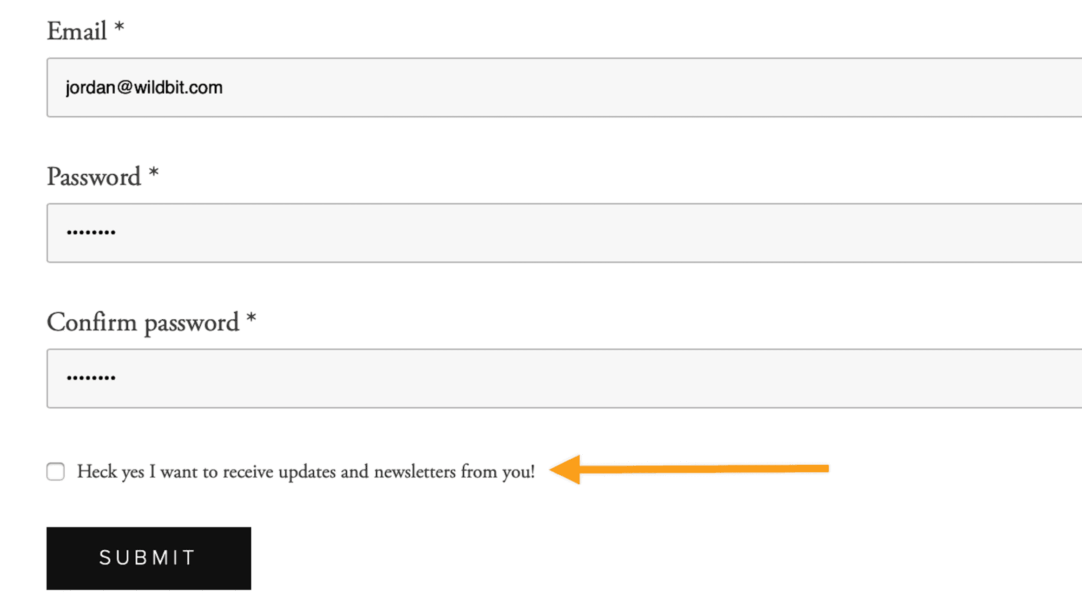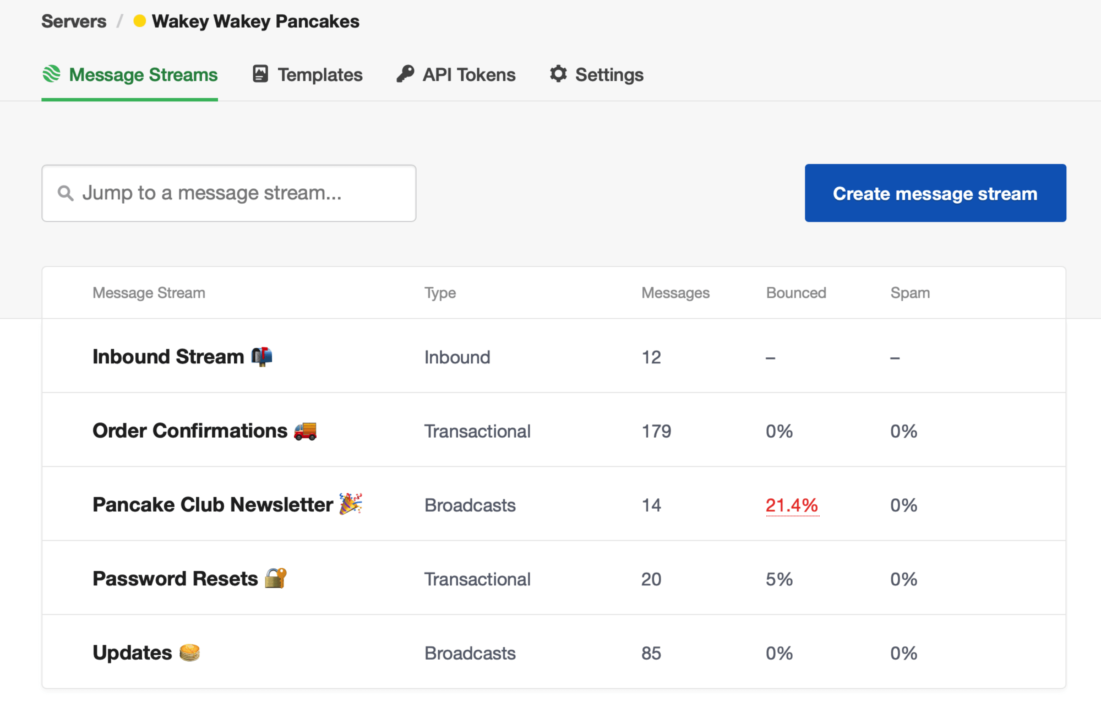Postmark Message Streams make it easy peasy to start sending out transactional and bulk messages on your customer's behalf. But hold your horses there cowpoke, as there are a few important factors to consider before allowing your customer to hit that send button.
Factors? Horses?! I know, right? I don't mean to be a Debbie Downer here, but this is important stuff! One bad sender can put your sending reputation—and that of your other customers—at risk. As my ol' Grammy used to say "One bad apple can spoil the whole barrel." Wise woman, ol' Grammy!
So before you allow a customer to start sending through your Postmark account, you'll want to do some vetting to make sure their sending practices match up with Postmark's Terms of Service requirements, Postmark's best practices for sending Broadcast or Transactional messages, and any other rules that you may have in place on your end. After all, rules are rules!
Allowing anyone to send unregulated through your Postmark account can put your own sending reputation—and that of your other customers—at risk.
To help you with this, we've made a checklist you can use to vet potential customers before you let them send email through your Postmark account. If they meet each of these requirements, you've found yourself a great customer and sender. Send away, fellow customer! If they don't meet each of these requirements, then you'll want to work with them to help them understand why these requirements are important and how they can adopt these practices before they're allowed to send through your Postmark account.
Below that, you'll find our Customer Setup Checklist that you can use while setting up new customers in your Postmark account to ensure they're getting the most out of sending through Postmark.
Important! Sending on behalf of someone who causes consistent deliverability issues could ultimately affect your own standing in Postmark, resulting in temporary sending suspensions until the issue is resolved. Following these checklists and continuing to weed out bad practices in your system will ensure that you see optimal deliverability throughout your account and that you and your customers stay within Postmark's policies.
APPROVING CUSTOMERS FOR SENDING THROUGH POSTMARK #
If you have a new customer who wishes to send through your Postmark account, first make sure they're a good fit for you and for Postmark. Use the Customer Approval Checklist below while you vet your new customer. If they check each box they are indeed a great fit for sending through Postmark.

Did all recipients opt-in to receive the messages your customer plans on sending to them? #
Postmark requires that lists and recipients be permission-based subscriptions. This means that recipients have explicitly opted-in to receive the messages your customers plan on sending them. With that in mind, customers who want to send to purchased lists, free lists, acquired lists, or cross-branded lists are not a good fit for sending through Postmark.
Back To Customer Approval Checklist
Was the opt-in process clear for each recipient? #
It's important that recipients have explicitly opted-in to receive the exact messages that your customer plans on sending to them, or it's made clear that by taking a specific action, they'll receive an email. This means providing a highly visible and clear way for the recipient to opt-in to your customer's future sending.
For example, an unchecked checkbox that the recipients can check if they're interested in receiving your newsletters is a great example. It's not good practice to bury the fact that you're adding a recipient to your sending list within a Terms of Use on sign up or hiding such details in the small print.

For transactional messages, you'll want to confirm that the customer's recipient is always aware that taking a specific action will result in an email. So, for example, clicking on a "Forgot password link" will obviously result in a password reset email being sent.
But there are some scenarios where a customer might not be aware they'll be receiving a transactional message, like a cart abandonment message—which is not a message type that Postmark supports. In those scenarios, the customer is unaware that by leaving an item in the checkout, they'll be receiving a follow-up message. It's not a great experience and can lead to increased spam complaints.
So it's essential you ask your potential customer for proof of their opt-in and transactional triggering processes. Ask for a list of all of the ways their messages are triggered by recipients and request newsletter sign-up form URLs. Be sure to review everything to ensure there's a clear and transparent opt-in option.
Back To Customer Approval Checklist

Was there a clear opt-out process? #
Having a clear and easy opt-out process is incredibly important to ensure you're weeding out recipients who no longer wish to receive your messages. This helps reduce the chances of spam complaints and low engagement—which in turn improves your overall sending reputation.
With that in mind, take a close look at how your customers previously handled unsubscribes before moving to Postmark for sending. Did their previous bulk messages include a visible unsubscribe link in all bulk messaging? How did they handle unsubscribes to ensure recipients did not receive future messages?
Understanding these past practices can help shed some light if there are areas your customer can improve.
Here's a friendly reminder that Postmark requires a visible unsubscribe link in all bulk Broadcast sends, which we cover in-depth here.
Back To Customer Approval Checklist
Can your customer provide past email sending stats? #
Asking a customer for insights into their past sending is a great way to find out whether they'd be a good fit for sending through your Postmark account. It's totally acceptable to ask your potential customer for details about what tools they've used in the past for sending these messages and to see some of their past statistics and reports from those senders.
If a customer seems wary to provide you with some basic information and stats, it's a red flag that they may not have followed sending best practices in the past and you should steer clear.
You'll want to make sure their past statistics show they've constantly maintained a bounce rate below 10% and a spam complaint of 0.1% or lower, as per Postmark's Terms of Service.
Back To Customer Approval Checklist

What does past list management look like? #
Learning how your customers previously handled their recipient lists and engagement is a great indicator of whether they're a good fit for sending through Postmark. Great list management requires a bit of effort, but the end results are well worth it as it helps keep their sending reputation shiny and clean.
One example is ensuring that your customers prune inactive recipients from their bulk sending lists. Permission to send (and email address validity in general) can go stale quite quickly. We've found that sending to recipients who you've not been in touch with recently can lead to high bounce and spam complaint rates. After around three months the recipient may have forgotten they previously opted-in to receive those specific messages, or their email address may no longer be active.
As such, we recommend removing inactive email addresses after 3 months—so you'll want to check if your customer takes a similar approach to list hygiene. And if they already have a list of inactive email addresses, you can help them add it to the Suppressions tab in their Postmark Message Stream.
It's also very important to understand how your customers handled hard bounces, unsubscribes, and spam complaints in the past. Did they ensure they no longer sent to recipients who unsubscribed? How did they manage and fix hard bounces before sending to the recipient again?
If you find your customer did not previously engage in these practices, it's important to educate them on why taking such measures are so important. You can also help get them set up with Postmark's Subscription Change Webhook so that they're alerted anytime a recipient is added to their Suppressions tab.
Back To Customer Approval Checklist
SETTING UP CUSTOMERS IN YOUR POSTMARK ACCOUNT #
If your new customer checks each of the boxes above, well then good news—you've found yourself a keeper! Woo! But before they start letting the emails fly there are still a few important steps to take. Use the Customer Setup Checklist below to help ensure you and your customers gets the most out of using and sending through Postmark.

Set up each customer on their own Server #
Having each customer set up on their own Server helps separate their sending, activity, and stats. This makes it easy to see which customers are seeing awesome open rates and helps identify which customers may be struggling with their deliverability.
Then, within each Server, you can separate a customer's sending, even more, using Message Streams.
For example, in my Wakey Wakey Pancakes customer's Server, I've created a Message Stream for each different type of message they send. This way I can see how their Password Reset emails are faring and get a quick idea if their Pancake Club Newsletters are having any bounce issues.

Also, should we ever need to temporarily pause a customer's sending due to a high bounce or spam complaint rate, we can pause sending in the single Message Stream in question—ensuring that sending within your other Message Streams and Servers remain unaffected.
With that in mind, we always recommend you set up each customer on their own Server, and then further separate that customer's sending even more using Message Streams.
Back To The Customer Setup Checklist
Set up customers with the proper user permissions #
Now that each customer is set up within their own Server, make sure you adjust their user permissions accordingly. Postmark makes it easy to invite users to just specific Servers so that they gain access only to the necessary information.
You can even set up a user to have Server view access only—meaning they are only able to view reports, email activity, and receive email digests for the Server(s) they are assigned to. This user permission level is a great way to provide a customer support agent the ability to view if a message was successfully sent or if there was an issue with deliverability.
Back To The Customer Setup Checklist

Ensure that each customer uses their own sending domain and branding #
It's important to make sure that each customer in your Postmark account uses their own, unique sending domain. Using a single sending domain for multiple customers is a big no-no and should be avoided at all costs! Sharing a sending domain makes it too easy for just one of your customers to have a bad send, which will then impact the reputation and deliverability rate for the messages of your other customers using that domain.
Using separate sending domains helps customers build up their own sending reputation and increase deliverability. Give them the control over handling their own deliverability destiny!
It's also important that each customer use their own FROM name and branding. This helps keep the email's details consistent and ensures receiving mail servers do not grow wary of their messages.
For example, spammers and phishers routinely send messages where their FROM email address doesn't quite match up with the branding and FROM name they're using. You know what I'm talking about—we've all received that message from a sender claiming to be PayPal, "helpfully" alerting us that there's an issue with our account. But taking a closer look you notice that the sender's FROM address, "security-paypal-center@int.paypal.org", and the links in the message don't quite match up with PayPal's actual domain. So while the branding is spot on, the mismatch with the sending details is highly suspicious.
So it's best to avoid looking like a spammer by ensuring the message's FROM domain, FROM name, URL domains, and branding (the logo, images, address, etc) all match the customer who is sending the message and their own branding.
Our deliverability expert gives more insight here on the different types of domains that email receivers care about.
Back To The Customer Setup Checklist
Authenticate your customer's sending domain #
Sending from a fully authenticated domain is an email industry standard nowadays and is highly recommended when sending through Postmark on your customer's behalf. If your customer does not send using an authenticated domain, their messages will likely see some major deliverability issues.
As such, it's important that your customers use their own custom domain with fully aligned authentication, including DKIM and a custom Return-Path.
We definitely understand that not all customers will feel comfortable modifying their DNS settings. It can seem intimidating if you're not used to editing DNS zones! To help, we have tons of great resources you can share with them about verifying a domain across some major DNS providers, and of course, our support team is always happy to help!
Back To The Customer Setup Checklist

Ensure each customer follows best sending practices #
Now that you've used the checklist above for vetting your customer to send through your Postmark account you'll want to make sure they continue to follow best practices going forward.
We have an in-depth guide on best practices when sending transactional messages that can be a useful tool for your customers to follow as they use Postmark to send their password resets, order confirmation, and other one-off messages.
And we've curated some of the best hints and tips for using Postmark to send bulk Broadcast messages. When followed, your customers will be seeing high engagement rates and some super sweet deliverability.
Back To The Customer Setup Checklist
Encourage using Webhooks and other tools #
Postmark's Webhooks are a great way to keep a pulse on your sending deliverability and activity. Encourage your customers to use them to automatically record and archive necessary data and stats, or to use the Subscription Change Webhook to get alerted any time a recipient is made inactive due to a hard bounce, unsubscribe, or spam complaint.
Or even help them set up our Slack App integration, so they can be automatically alerted within one of their own Slack channels anytime a bounce occurs or if Postmark's status is updated.
Back To The Customer Setup Checklist

Well, there you have it! You've ensured your new customers meet all of the approval requirements listed above, and you've taken steps to help set up your customer in your Postmark account in the best possible way. Bravo! These actions ensure that the customers you send on behalf of are ready to get the most out of what Postmark has to offer a see some stellar deliverability results.
Have questions? Comments? Or just need a few suggestions for some experimental yet highly delicious ice cream combinations? Give us a shout and we'll be happy to help.



